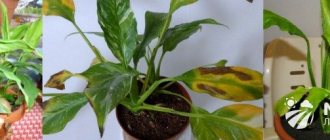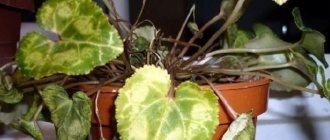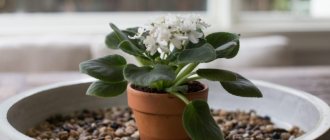What kind of water to water indoor flowers?
Many novice gardeners use tap water to water their indoor flowers. It's not so bad, but it contains chlorine and lime, which plants don't like at all. High chlorine levels in tap water can cause shoot tip dieback and leaf scorch.
To avoid this, pour water into the watering can in advance. Let it sit for at least a day - during this time it will warm up to room temperature, settle, and the chlorine will evaporate from it.
After watering with settled water, whitish spots may appear on the surface of the soil and on the leaves. To soften tap water and avoid the formation of plaque, you can add lemon juice or a few grains of citric acid to it. You can also use vinegar (10 drops of table or apple cider vinegar per 1 liter of water), wood ash (3 g of ash per 1 liter of water) or a special lime neutralizer, which is sold in flower shops.
Replant into new soil
Replant the flower in new soil, not forgetting to take care of a good drainage system. To do this, choose a pot with special holes to drain excess moisture.
The drainage layer should be 2-3 cm thick. For this you can use pebbles or expanded clay.
When the replanting is complete, take your time to place the pot in a sunny window. In such conditions, the flooded roots will quickly dry out, and the green pet will simply die.
To prevent this from happening, for the next 2-3 weeks, remove the plant to a shaded place where there are no strong drafts. It is important that the room has a stable temperature of +18-20°C.
How often to water indoor plants in winter
One of the most common mistakes made by indoor floriculture enthusiasts is unregulated watering. In the warm season it is better to water the plants in the evening, and in the cold season - in the morning.
In autumn and winter, the frequency of watering should be minimized. I can’t recommend an exact time period, because the location of the plants and air humidity in each house are different. I advise you to focus on the condition of the soil: if it is loose (don’t forget to loosen the soil), then you can check the moisture with your finger, deepening it 2 cm. If there are no traces of soil left on your finger, you can water the plant.
You can also use a soil moisture meter - these are sold in flower departments. For me, this device is my number one assistant. When immersed in the ground, the sensor shows the degree of moisture: “dry”, “wet”, “too wet”.
If, when watering, water immediately pours out of the pot, almost without being absorbed into the soil, it means that the soil has dried out. You should saturate it with moisture - immerse the potted plant in a container of water up to the soil level.
Setting up watering
For the first 2-3 weeks, until the plant has recovered, water so that the soil remains slightly moist and not soggy.
Then move the pot to a sunny window, find out what kind of watering regime this species requires, and try to strictly adhere to it. Place a special sign or label next to the pot, on which it is convenient to write down the necessary care information.
Remember that you can save a flooded flower only with an emergency transplant. If you delay it a little, the root system of the green pet will begin to rot, and it will simply die.
How to determine the lack or excess of moisture in a flower pot
With a lack of water , plants grow poorly, their leaves become drooping and withered, the edges of the lower leaves become brown and dry, the flowers quickly wither and fall off.
When there is excess water , the leaves fall off, signs of rot appear on them, the lower leaves turn yellow, their tips turn brown, the flowers may become moldy, and the roots may become soggy.
In addition, plants can be divided into groups according to the degree of soil moisture they require:
- excessive watering - there should be a lot of moisture in the soil. These are cyperus, calamus, adiantum, azalea;
- abundant watering - you need to constantly keep the soil moist, but the water should not stagnate. Most ornamental plants belong to this group. For example, alocasia, begonia, heliotrope, calathea, lemon, oleander, ivy need such watering;
- moderate watering - before the next watering, you need to let the top layer of soil (about 2 cm) dry out a little. These are aglaonema, aspidistra, dracaena, clivia, columna, monstera, palm trees, syngonium;
- infrequent watering - the soil must be kept dry, and the plant must be watered only during the growth period. These are hippeastrum, gloxinia, zygocactus, caladium, crinum, epiphyllum, philodendron, cacti, succulents.
Symptoms of overwatering flowers
How can we understand that this is a plant suffering from waterlogging? Leaf falling is one of the symptoms. In a number of plants, such as citrus fruits, they literally fall off - they darken and fall off. In others, for example, in aroids (Aglaonema, Dieffenbachia) or arrowroot, they darken, but still stay on the stems for a long time. In plants that form rosettes of leaves or pseudo rosettes (yucca, dracaena), the leaves do not darken immediately, but first become discolored and become pale yellow. But in other cases, a characteristic difference between leaves that die from waterlogging is darkening of the leaf. The leaf doesn’t just turn yellow, it actually darkens, the color changes from a healthy juicy green dirty-swamp shade, gradually turning into brown. If waterlogging is preceded by overdrying, the leaf first turns yellow, then the leaf petiole and the leaf itself darken.
Rotten roots split, the top layer of the root becomes dirty gray, peels off if you run your fingers through it, leaving a thin, hard core. These roots all died from waterlogging.
And these are healthy living roots - green, yellowish or whitish, in some plants a rich brown color.
Sudden or gradual falling of leaves, blackening of shoots, damp, sour soil...
The trunk still seems alive and green, but the roots have rotted and the plant can no longer be saved.
When a plant does not have enough water, the leaves always turn yellow, while the leaf tissues may lose elasticity, droop, or remain dry. After watering, turgor is restored and the leaves become elastic again. If there is insufficient nutrition, then interveinal chlorosis may appear; the leaves do not droop, continue to grow, but become smaller. When overmoistened, the leaves may lose their elasticity and droop, but after watering the elasticity is not restored, and the darkening of the leaves, on the contrary, increases. Sometimes the leaves can fall off even without darkening - still green. But leaf fall can also occur from watering with cold water. Ideally, the water temperature for irrigation should be 2-3°C higher than the room temperature, but not lower than 22°C. Cold water is not absorbed by the roots, causing the suction roots to die from hypothermia, and, as a result, leaves to fall off.
As for water hardness, it cannot be the reason for the sudden falling of leaves and death of the plant. If you water plants with hard water, even the most capricious ones, sensitive to excess salts, the plants will not begin to lose leaves en masse. All the damage manifests itself gradually: first, chlorotic spots appear, the tips or edges of the leaves turn brown, one or two leaves turn yellow, new leaves grow small and the plant looks depressed, but leaves do not fall off.
In case of massive leaf fall, when leaves fall off not one by one, but dozens at once, the reasons may be the following: sudden hypothermia (for example, during transportation home), watering with concentrated fertilizer (burning roots), severe drying out, and only hygrophytes and mesohygrophytes fly around en masse (and there are few of them), and waterlogging. Naturally, the first two reasons can be easily calculated, and it is also possible to distinguish overdrying from overwatering, but for this the plant must be removed from the pot. It is not always possible to feel the soil with your finger at depth (for example, the roots have grown greatly), and only by removing the plant from the pot can you determine whether the soil inside the root ball is wet.
Some gardeners wait until the last minute, not wanting to remove the plant and inspect the roots. They are either selflessly confident that there was no waterlogging, or they are afraid that an unscheduled transplant will damage the plant. But if there is even the slightest suspicion of waterlogging, don’t even doubt it - take it out and inspect the roots. Sometimes the root system of plants grows in this way: at the top the roots are not dense, the soil dries out easily between them, and in the lower part of the pot the roots form a tight ring, the intertwining of the roots makes drying difficult and in the lower part of the pot the soil dries for a very long time. This is especially aggravated by the fact that the holes at the bottom of the pot are small and clogged with pebbles or grains of earth.
The tangerine is the result of waterlogging and acidification of the soil. Chlorosis is a lack of various microelements.
This deplorable condition is the result of hypothermia of the root system: watering with cold water or the plant is left with damp soil on a cold balcony or outside.
There is also a deplorable symptom that is characteristic of severe, prolonged waterlogging - darkening, blackening and wilting of the tops of the shoots. If a similar picture occurs, then the matter is already very neglected, and often it is simply impossible to save the plant. If the tops of all the shoots have rotted (yellowed or darkened), there is nothing left to save. A similar picture is possible only with severe hypothermia of the roots, and never occurs when the roots are overdried. When overdrying, wilting begins with old leaves, with lower shoots, and the trunk becomes bare from below. When overmoistened, the leaves wither in any part of the crown, but more often from above, from the tops of the shoots.
And of course, any softening of the stems or leaves of plants with fleshy parts of the body, and these are yuccas, dracaenas, dieffenbachias, any succulents (crassulas, adeniums, etc.), cacti - a sure sign of excess moisture.
Another symptom that is not entirely correct and does not always indicate a specific plant, but still makes you think, is the presence of fungus gnats. If a swarm of midges flies up from the pot, it means that you watered the flowers too much, perhaps it was once or twice, or perhaps you have become a habit of over-watering. Unlike mosquitoes, poduras (colembolas) are white or dirty-gray insects, about 1-2 mm, jumping on the surface of the ground in a pot - a sure sign that the flower is flooded more than once.
What to do if the flower is flooded?
A common situation: “While I was on vacation, I entrusted flowers to my husband. He poured the monstera. So what's now?"
Urgently replant the plant: remove it from the pot onto previously spread newspapers, blot it thoroughly, let the roots dry, shake off the old, wet soil and place it in a pot with a large drainage hole and new drainage.
If the plant has already begun to turn yellow and the trunk has become soft, it means that the roots have begun to rot. To save the plant, it also needs to be transplanted into new soil, but before that you need to inspect the roots: rotten ones should be cut off.
If there is nothing left to save - there are no living roots - then you can cut a living trunk and try to root it (it is advisable to do this not in water, but in a peat tablet, but it depends on the plant). This way you will still have this look.
Checking roots
If the plant has been overwatered, that is, there is stagnation of water in its root system, then you need to act as quickly as possible. First you need to check the root system of your indoor plant for rot. To do this, the flower is pulled out of the damp soil mixture, carefully, trying not to damage the roots. Dry them and inspect them for the presence of putrefactive formations. If damage is found on the plant, it must be carefully removed by cutting it off with a sharp knife, which should be disinfected in advance.
Blueberries for growing at home at a competitive price (advertising)
What air humidity should be maintained in an apartment where there are indoor flowers?
For tropical plants, the optimal air humidity is 85-95% in summer and 70-80% in winter, for subtropics in pots - 60-70%, queen orchids need to create a humidity of 50-80%.
My house usually has 50% humidity in the summer and 20% in the winter (with central heating). This is not enough. This is why the leaves of indoor flowers dry out.
I offer you simple ways to humidify the air:
- open containers with water;
- wet towels on heating radiators (in winter);
- wet pebbles in the tray;
- sphagnum moss in pots;
- water sprayers.
Humidifiers have always been and remain the ideal option. Steam humidifiers have proven themselves better than ultrasonic ones. Steam humidifiers are used in many indoor plant nurseries.
By the way, plants are perhaps the best air humidifiers after aquariums and home ponds. Therefore, if you want to breathe clean, moist air, consider landscaping your home.
What is the danger of flooding a plant and how can you tell if it is over-watered?
Signs of orchid bay are:
- lethargy, wrinkled leaves or their softness;
- yellowing and death of pseudobulbs;
- falling of flowers and buds;
- mold formation on the soil;
- the orchid “wobbles” in the pot because the rotted roots can no longer hold it;
- Spores or algae are visible on the inner walls of the pot.
The problem is that it will take a long time before signs of flooding appear in the orchid's appearance.
Stagnant moisture is the “hidden killer” of orchids. Rotting and death of roots occurs gradually, so the appearance of the plant from above does not change immediately.
If the orchid is grown in a transparent pot, then you can determine from the state of the root system that it is being overwatered:
- entire areas become thread-like;
- the roots become very dark;
- damage or even mold is noticeable.
It is important not only to determine overflow, but also to know what to do next with such a plant.
To water or not to water – that is the question
For those who have little experience in floriculture, it is difficult to determine whether it is time to water their favorite flowers or should they wait. In such a situation, I recommend refraining from watering for another 2-3 days. It's always better to under-hydrate than over-hydrate.
A slight drying out is not a problem even for moisture-loving plants. But overfilling will have undesirable consequences. Especially if it happens regularly. Due to drought, small peripheral roots may die, which will quickly grow back. While roots that have rotted from excess water cannot be helped.
Differences in watering in winter and summer
In summer, plants actively vegetate - they grow shoots, leaves, and buds. Add to this the high air temperature. Of course, the earth will dry out faster, the flowers need more moisture. This means that watering should be more abundant than in the cold season, even for the same flower.
In winter, watering should be carried out 1.5-2 times less often and with less water, taking into account the characteristics of a particular plant. Some species need a rest period and are practically not watered, being kept at a low temperature (from +8 to +15 degrees).
This applies to:
- azalea;
- cyclamens;
- pelargonium;
- hydrangeas;
- cacti;
- myrtle;
- oleander.
The list includes many other plants. It is better to clarify the features of the life cycle of a flower when purchasing or later by looking at thematic sites on the Internet.
At low temperatures, flowers are watered occasionally (about once a month) and sparingly. If you continue to water them as usual, the roots will quickly rot in the cold soil.
The life processes of these plants are organized in such a way that they need winter rest. Many of them require drastic pruning in the fall. In spring, the plant will again grow new leaves, produce new shoots, and then the previous watering regime must be resumed.











